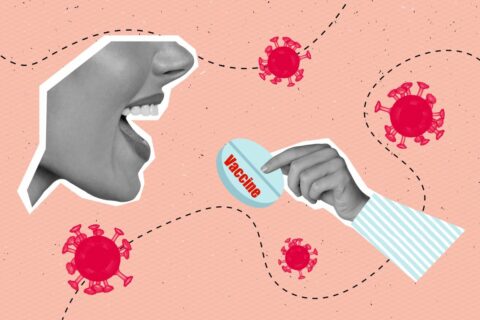Oral vaccines from organisms found in volcanic regions

FAU team conducts research on new delivery method for mRNA active ingredients
The success story of Covid-19 vaccines based on mRNA technology is set to improve significantly with a vaccine that can be swallowed easily. Around three million euros has been allocated by the Federal Ministry for Economic Affairs and Climate Action for funding this project, which FAU, the companies BianoGMP, IFB, Ionovation and CAM-D Technologies, and external research institution iba want to implement by the end of 2025. However, the most important members of the development team are microorganisms that normally live in volcanic areas.
These exotic workers can easily skip the biggest hurdle for an oral vaccine with mRNA: Before such a vaccine can develop its protective effect in the intestine, it must first pass through the stomach. However, this organ is one of the most extreme places in the body of humans and animals. “The stomach is not only very acidic, but also teems with enzymes that break down our food into its components,” explains Prof. Dr. Dagmar Fischer. Professor Fischer is Chair of Pharmaceutical Technology and Biopharmacy at FAU and heads the central area of production in the oral vaccination project “TEL DrugDelivery”, in which TEL stands for tetraether lipids.
Tetraether lipids are biomolecules that are crucial for the survival of microorganisms in inhospitable volcanic areas. Some of these tiny organisms not only have to withstand very high temperatures, but also extreme acid baths that destroy almost all biomolecules. Cell walls of normal bacteria, which consist of lipids, i.e. water-insoluble substances, are quickly cracked by these acids. However, special biomolecules, known as “archaea”, resist corrosive acids with the help of the TEL special lipids. These archaean biomolecules are likely to survive the path through the stomach.
New special lipids as safe packaging for mRNA vaccine
But even with a vaccination in the upper arm muscle, it is necessary to pack the vaccine in lipids – even if they do not have to survive an acid bath in the stomach. “The vaccines consisting of the mRNA biomolecule are very sensitive, even without strong acid they are broken down into their components within a few minutes,” explains the project coordinator Dr. Tobias Pöhlmann from the company BianoGMP. For this reason, the mRNA is packaged in lipids that can not only stabilize the vaccine, but also inject it into the cells of the body. In an mRNA vaccine, a specific protein of the pathogen is produced according to the blueprints in the mRNA. This is how the immune system detects parts of the virus and begins to fight it. If a vaccinated person later becomes infected with the Covid-19 pathogen, the immune system remembers the vaccine, starts to fight the infection quickly and usually ensures a milder course.
Oral vaccine has many benefits
Compared to a vaccination via injection, an oral vaccine offers considerable advantages. For example, the vaccine can be packaged in capsules or pressed into tablets that can be stored at normal temperatures. Existing Covid-19 vaccines, on the other hand, have to be deep frozen for transport which already poses some challenges in Germany, but is hardly possible in many countries of the global south and especially in remote regions. Further, the relatively complex injection is avoided and an oral vaccine works for the vast majority of people even without great deal of guidance.
Now FAU pharmacist Dagmar Fischer is looking for good acid protection for safe passage through the stomach. This should hopefully work excellently with the TEL special lipids, which are to be produced with sustainable technologies – FAU’s partners have much experience to share in this area. The mRNA vaccine must be packaged in the TEL so that it can be transported efficiently, stably and safely via the mouth and stomach to the intestine. Dagmar Fischer tackles this task with modern methods and the help of other partners who, for example, use sophisticated computer programs to work out how to chemically modify the TEL for this purpose. The algorithms extract valuable information, which is then put into practice in the laboratory.
Safety is utmost priority for Covid-19 vaccine
The modified TEL, which is well adapted to its task, is assembled by Dagmar Fischer’s team into small lipid containers called “archaeosomes”. The project will then put the delivery system through its paces together with the mRNA. What is the most stable way to package this vaccine in TEL containers using the information gathered by the algorithm? Can the archaeal lipids be modified in such a way that they cooperate as well as possible with the intestinal cells, release the mRNA effectively and trigger the immune response in the most effective way? Conditions in the oral cavity, in the stomach and in the intestine are simulated in the laboratory. “We don’t just look at how stable the mRNA survives this environment, but also examine whether the archaeosomes can damage the cells of the intestine, for example,” explains Dagmar Fischer. After all, the vaccine must also be safe.
Method for fighting infections and tumors
At the end of the project, FAU and its partners want to deliver an mRNA vaccine against Covid-19, which is not only ideal for oral administration, but that is mainly produced sustainably from microorganisms. “We want to develop a platform that also transports vaccines other than the Covid-19 vaccine,” says FAU Professor Dagmar Fischer. Finally, mRNA vaccines have a promising future in the fight against other dangerous infections and tumors. And oral vaccines are very convenient in any case.
Further information
Prof. Dr. Dagmar Fischer
Chair of Pharmaceutical Technology and Biopharmacy
Phone: +49 9131 85 29552
dagmar.fischer@fau.de